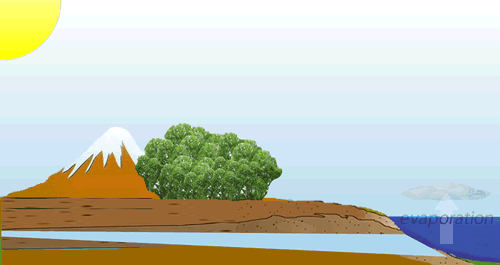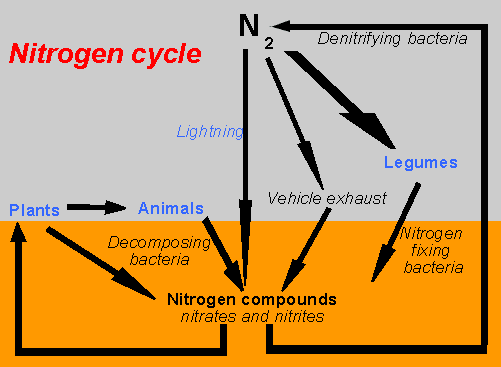
Consider the Earth as a closed ecosystem. It requires energy which it gets in abundance from the Sun, a source of water and nutrients which it has in limited amounts. Although energy must be constantly supplied, all other essential factors must be recycled.
What happens in an ecosystem?
"Matter can not be created nor can it be destroyed during chemical reactions". Translated, this means that the amount of each element on Earth is fixed and it has to be shared and recycled back to the environment when organisms die. Unlocking and releasing key nutrients and elements in dead animals is the work of a group of organisms known as the decomposers, made up of bacteria and fungi.
If it wasn't for this group of organisms vital elements would soon become scarce on Earth and all life would cease to exist.

We will look at three cycles vital to any ecosystem, the carbon , the nitrogen and the water cycles.

Water cycles through the environment driven by the Sun's energy, in its three states of matter. Large stores of liquid water are found in the oceans and a small amount is found as fresh water in lakes and other inland reservoirs.
A smaller amount, when compared to oceans, but significant, is the water found in the atmosphere as water vapour. This forms the clouds and rain and in this form water can move very quickly to different locations and become available to terrestrial ecosystems.
Fresh water is also trapped in its solid state as ice at the poles and on mountain peaks.
Humans can manipulate local water cycles for the generation of power.
Carbon an essential element for all life on Earth is cycled through many sinks as shown, simply, on the right.
Recently, climate change has taken centre stage identifying anthropogenic carbon dioxide as the main culprit.
In a closed ecosystem the carbon dioxide that is produced through animal and plant respiration is used by plants to photosynthesise and recycle oxygen. In this situation carbon dioxide production and removal are balanced. The problem, however, starts when human activity pumps more carbon dioxide into the air than can be absorbed by the plants and other carbon sinks.


Nitrogen is an essential element for life. It is one of the building blocks of DNA and proteins. It is recycled through the ecosystem by bacteria and lightning, as shown on the left.
Although there is plenty of nitrogen in the atmosphere it is unusable in the gas form (N2). Only when nitrogen is incorporated with other elements can plants and animals use it. Plants take up inorganic forms of nitrogen such as nitrates (NO3- ) and produce organic compounds that contain nitrogen,such as amino acids, that animals can use. Animals need plants not for oxygen only but for vital nitrogenous compounds as well.
Decomposing bacteria play a vital role in releasing the nitrogen trapped in the organic matter of dead organisms, thus making it available to other organisms.
To answer the questions below use all the links provided on this page.
1) What are three ways atmospheric nitrogen is converted into usable nitrogen compounds in a process called nitrogen fixing?
2) What is the role of denitrifying bacteria?
3) What would happen to an ecosystem if the decomposing bacteria died out?
4) Name one class of organic compounds that contain nitrogen that are produced by plants only.
5) Where does the nitrogen in our bodies ultimately come from?
6) What sort of organisms fix nitrogen
7) Why would an ecosystem benefit from a thunderstorm?
8) According to the diagram above how do animals get their nitrogen compounds?
9) synthesise nitrates while use them to form organic matter.
10) What is a carbon sink?
11) Which of the following is not a carbon sink?
12) What is an anthropogenic source of carbon dioxide?
13) Which activity can cause an increase in atmospheric carbon?
14) The water cycle is powered by the
15) What two type of organisms decompose organic matter?
16) Explain what would happen if decomposers were to become extinct in a particular ecosystem.
17) Describe how the water cycle is manipulated by humans to generate power.
18) What are some of the ecological consequences of hydroelectricity?